Tribological Properties of Nano-ZrO2 and PEEK Reinforced PTFE Composites Based on Molecular Dynamics
Abstract
:1. Introduction
2. Materials and Methods
2.1. Preparation of PTFE Composites
2.2. Friction and Wear Test
2.3. Construction Method of Molecular Dynamics Model for PTFE Composites
3. Results and Discussion
3.1. Effect of ZrO2 Nanoparticles and PEEK on the Tribological Properties of PTFE Composites
3.2. Effect of ZrO2 Nanoparticles and PEEK on Morphological Characteristics of PTFE Composite Transfer Films
3.3. Molecular Dynamics Simulation of Tribological Behavior of PEEK and Nano-ZrO2 Reinforced PTFE Composites
3.3.1. Restricted Three-Layer Structural Shear Friction Model of Fe Atomic Layer and Polymer
3.3.2. Molecular Dynamics Simulation of the Friction Behavior of PTFE Molecular Chains with Fe Atomic Layers
3.3.3. Molecular Dynamics Simulation of Tribological Properties of PEEK Particle Reinforced PTFE Composites
3.3.4. Molecular Dynamics Simulation of Tribological Properties of Nano-ZrO2 Particle-Reinforced PTFE Composites
4. Conclusions
- Adding soft-phase PEEK particles and hard-phase ZrO2 nanoparticles into the PTFE matrix could significantly enhance the wear resistance of the PTFE composites. However, the friction coefficient might also increase to varying degrees. During the steady friction stage, the nano-ZrO2/PEEK/PTFE composite exhibited the lowest volume wear rate of only 1.76 × 10−6 mm3/Nm, which was 204 times higher than the wear resistance of pure PTFE.
- Both PEEK and nano-ZrO2 played essential roles in the morphological characteristics of the transfer film and its development behavior. The hard-phase ZrO2 nanoparticles could rapidly cut and minimize the debris and anchor them on the counterpart metal, thereby increasing the formation rate of the early transfer film. In the later friction stage, the ZrO2 nanoparticles could also scratch the already-formed transfer film, destroying its integrity. On the other hand, the soft-phase PEEK particles could wrap around the hard-phase nanoparticles, effectively reducing the damage of the hard-phase nanoparticles to the transfer film. Therefore, the nano-ZrO2/PEEK/PTFE simultaneously exhibited the dual advantages of quickly forming a transfer film in the early stage of friction and maintaining a complete, uniform, and firm transfer film in the stable friction stage.
- Molecular dynamics simulations were employed to investigate the frictional behavior of four PTFE composites at the microscopic scale. It was found that pure PTFE exhibited significant intermolecular frictional sliding between polymer chains within the matrix during friction, and the -[-CF2-CF2-]-n chains migrated towards the frictional region from the middle of the matrix. The simulated friction temperature in the middle of the matrix reached 320 K, which corresponded well with the occurrence of large-scale sheet-like debris and extremely high volumetric wear rate in PTFE observed in friction experiments. Adding PEEK and nano-ZrO2 particles significantly suppressed intermolecular frictional sliding between polymer chains within the matrix, reducing the friction temperature in the middle of the matrix, improving the material’s resistance to shear deformation and overall stability, and enhancing the frictional performance of the PTFE composite.
Author Contributions
Funding
Data Availability Statement
Conflicts of Interest
References
- Speerschneider, C.J.; Li, C.H. Some observations on the structure of polytetrafluoroethylene. J. Appl. Phys. 1962, 33, 1871–1875. [Google Scholar] [CrossRef]
- Bunn, C.W.; Cobbold, A.J.; Palmer, R.P. The fine structure of polytetrafluoroethylene. J. Polym. Sci. 1958, 28, 365–376. [Google Scholar] [CrossRef]
- Zhang, Z.Z.; Liu, W.J.; Xue, Q.J. Effects of various kinds of fillers on the tribological behavior of polytetrafluoroethylene composites under dry and oil–lubricated conditions. J. Appl. Polym. Sci. 2001, 80, 1891–1897. [Google Scholar] [CrossRef]
- Wan, Y.Y.; Xie, T.; Yu, J.W.; Dong, M. Behavior of interface migration of polymer matrix composites during friction. Mater. Rep. 2010, 24, 75. [Google Scholar]
- Lv, M.; Wang, L.; Liu, J.; Kong, F.; Ling, A.; Wang, T.; Wang, Q. Surface energy, hardness, and tribological properties of carbon-fiber/polytetrafluoroethylene composites modified by proton irradiation. Tribol. Int. 2019, 132, 237–243. [Google Scholar] [CrossRef]
- Gweon, J.H.; Joo, B.S.; Jang, H. The effect of short glass fiber dispersion on the friction and vibration of brake friction materials. Wear 2016, 362, 61–67. [Google Scholar] [CrossRef]
- Song, F.; Wang, Q.; Wang, T. Effects of glass fiber and molybdenum disulfide on tribological behaviors and PV limit of chopped carbon fiber reinforced polytetrafluoroethylene composites. Tribol. Int. 2016, 132, 237–243. [Google Scholar] [CrossRef]
- Trabelsi, M.; Kharrat, M.; Dammak, M. On the friction and wear behaviors of PTFE based composites filled with MoS2 and/or bronze particles. Trans. Indian Inst. Met. 2016, 69, 1119–1128. [Google Scholar] [CrossRef]
- Lin, Z.; Qu, T.; Zhang, K.; Zhang, Q.; Wang, S.; Wang, G. Modeling of contact temperatures and their influence on the tribological performance of PEEK and PTFE in a dual-pin-on-disk tribometer. Friction 2023, 11, 546–566. [Google Scholar] [CrossRef]
- Amenta, F.; Bolelli, G.; D’Errico, F.; Ottani, F.; Pedrazzi, S.; Allesina, G.; Lusvarghi, L. Tribological behaviour of PTFE composites: Interplay between reinforcement type and counterface material. Wear 2022, 510, 204498. [Google Scholar] [CrossRef]
- Wang, H.; Qi, X.; Zhang, W.; Dong, Y.; Fan, B.; Zhang, Y. Tribological properties of PTFE/Kevlar fabric composites under heavy loading. Tribol. Int. 2020, 151, 106507. [Google Scholar] [CrossRef]
- Burris, D.L.; Sawyer, W.G. Improved wear resistance in alumina–PTFE nanocomposites with regular shaped nanoparticles. Wear 2006, 260, 915–918. [Google Scholar] [CrossRef]
- Yuan, Q.; Gong, J.; Cao, W.H.; Wang, H.G.; Ren, J.F.; Gao, G. Tribological behaviour of PTFE composites filled with PEEK and nano-Al2O3. Tribol. Trans. 2018, 61, 694–704. [Google Scholar] [CrossRef]
- Yue, W.; Gong, J.; Yang, D.Y.; Gao, G.; Wang, H.G. Tribological behavior of nano-Al2O3-reinforced PPS-PTFE composites. Tribol. Trans. 2014, 57, 173–181. [Google Scholar] [CrossRef]
- Wang, Q.H.; Xue, Q.J.; Shen, W.C. The friction and wear properties of nanometre SiO2 filled polytetrafluoroethylene. Tribol. Int. 1997, 30, 193–197. [Google Scholar] [CrossRef]
- Lei, F.; Hu, K.A.; Li, J.L.; Zhao, B.Y. The friction and wear characteristics of nanometer ZnO filled polytetrafluoroethylene. Wear 2001, 249, 877–882. [Google Scholar] [CrossRef]
- Khare, H.S.; Moore, A.C.; Haidar, D.R.; Gong, L.; Ye, J.; Rabolt, J.F.; Burris, D.L. Interrelated Effects of Temperature and Environment on Wear and Tribochemistry of an Ultralow Wear PTFE Composite. J. Phys. Chem. C 2015, 119, 16518–16527. [Google Scholar] [CrossRef]
- Harris, K.L.; Curry, J.; Pitenis, A.A.; Rowe, K.G.; Sidebottom, M.A.; Sawyer, W.G.; Krick, B.A. Wear Debris Mobility, Aligned Surface Roughness, and the Low Wear Behavior of Filled Polytetrafluoroethylene. Tribol. Lett. 2015, 60, 2. [Google Scholar] [CrossRef]
- Nunez, E.E.; Polycarpou, A.A. The effect of surface roughness on the transfer of polymer films under unlubricated testing conditions. Wear 2015, 326–327, 74–83. [Google Scholar] [CrossRef]
- Urueña, J.M.; Pitenis, A.A.; Harris, K.L.; Sawyer, W.G. Evolution and wear of fluoropolymer transfer films. Tribol. Lett. 2015, 57, 9. [Google Scholar] [CrossRef]
- Gosvami, N.N.; Bares, J.A.; Mangolini, F.; Konicek, A.R.; Yablon, D.G.; Carpick, R.W. Mechanisms of antiwear tribofilm growth revealed in situ by single-asperity sliding contacts. Science 2015, 348, 102–106. [Google Scholar] [CrossRef] [PubMed]
- Ye, J.; Khare, H.; Burris, D. Quantitative characterization of solid lubricant transfer film quality. Wear 2014, 316, 133–143. [Google Scholar] [CrossRef]
- Ye, J.; Khare, H.; Burris, D. Transfer film evolution and its role in promoting ultra-low wear of a PTFE nanocomposite. Wear 2013, 297, 1095–1102. [Google Scholar] [CrossRef]
- Schwartz, C.J.; Bahadur, S. Studies on the tribological behavior and transfer film–counterface bond strength for polyphenylene sulfide filled with nanoscale alumina particles. Wear 2000, 237, 261–273. [Google Scholar] [CrossRef]
- Bai, S.; Onodera, T.; Nagumo, R.; Miura, R.; Suzuki, A.; Tsuboi, H.; Hatakeyama, N.; Takaba, H.; Kubo, M.; Miyamoto, A. Friction reduction mechanism of hydrogen- and fluorine-terminated diamond-like carbon films investigated by molecular dynamics and quantum chemical calculation. J. Phys. Chem. C 2012, 116, 12559–12565. [Google Scholar] [CrossRef]
- Onodera, T.; Park, M.; Souma, K.; Ozawa, N.; Kubo, M. Transfer–film formation mechanism of polytetrafluoroethylene: A computational chemistry approach. J. Phys. Chem. C 2013, 117, 10464–10472. [Google Scholar] [CrossRef]
- Onodera, T.; Kawasaki, K.; Nakakawaji, T.; Higuchi, Y.; Ozawa, N.; Kurihara, K.; Kubo, M. Effect of tribochemical reaction on transfer–film formation by polytetrafluoroethylene. J. Phys. Chem. C 2014, 118, 11820–11826. [Google Scholar] [CrossRef]
- Onodera, T.; Nunoshige, J.; Kawasaki, K.; Adachi, K.; Kurihara, K.; Kubo, M. Structure and function of transfer film formed from PTFE/PEEK polymer blend. J. Phys. Chem. C 2017, 121, 14589–14596. [Google Scholar] [CrossRef]
- He, E.; Wang, S.; Li, Y.; Wang, Q. Enhanced tribological properties of polymer composites by incorporation of nano-SiO2 particles: A molecular dynamics simulation study. Comput. Mater. Sci. 2017, 134, 93–99. [Google Scholar] [CrossRef]
- Chawla, R.; Sharma, S. A molecular dynamics study on Young’s modulus and tribology of carbon nanotube reinforced styrene-butadiene rubber. J. Mol. Model. 2018, 24, 96. [Google Scholar] [CrossRef]
- Deng, P.; Fan, B.; Qi, X.; Yang, Y.; Hao, X. Investigation of ptfe tribological properties using molecular dynamics simulation. Tribol. Lett. 2019, 67, 28. [Google Scholar] [CrossRef]
- Swope, W.; Andersen, H.; Berens, P.; Wilson, K. A computer simulation method for the calculation of equilibrium con-stants for the formation of physical clusters of molecules: Application to small water clusters. J. Chem. Phys. 1982, 76, 637–649. [Google Scholar] [CrossRef]
- Cherif, K.; Gueroult, B.; Rigaud, M. Al2O3–ZrO2 debris life cycle during wear: Effects of the third body on wear and friction. Wear 1997, 208, 161–168. [Google Scholar] [CrossRef]
- Tang, L.; Li, Y.; He, E.; Hao, M.; Ren, S. Molecular simulation of tribology behavior of nano ZnO/nitrile-butadiene rubber composites. Acta Mater. Compos. Sin. 2020, 37, 690–695. [Google Scholar]
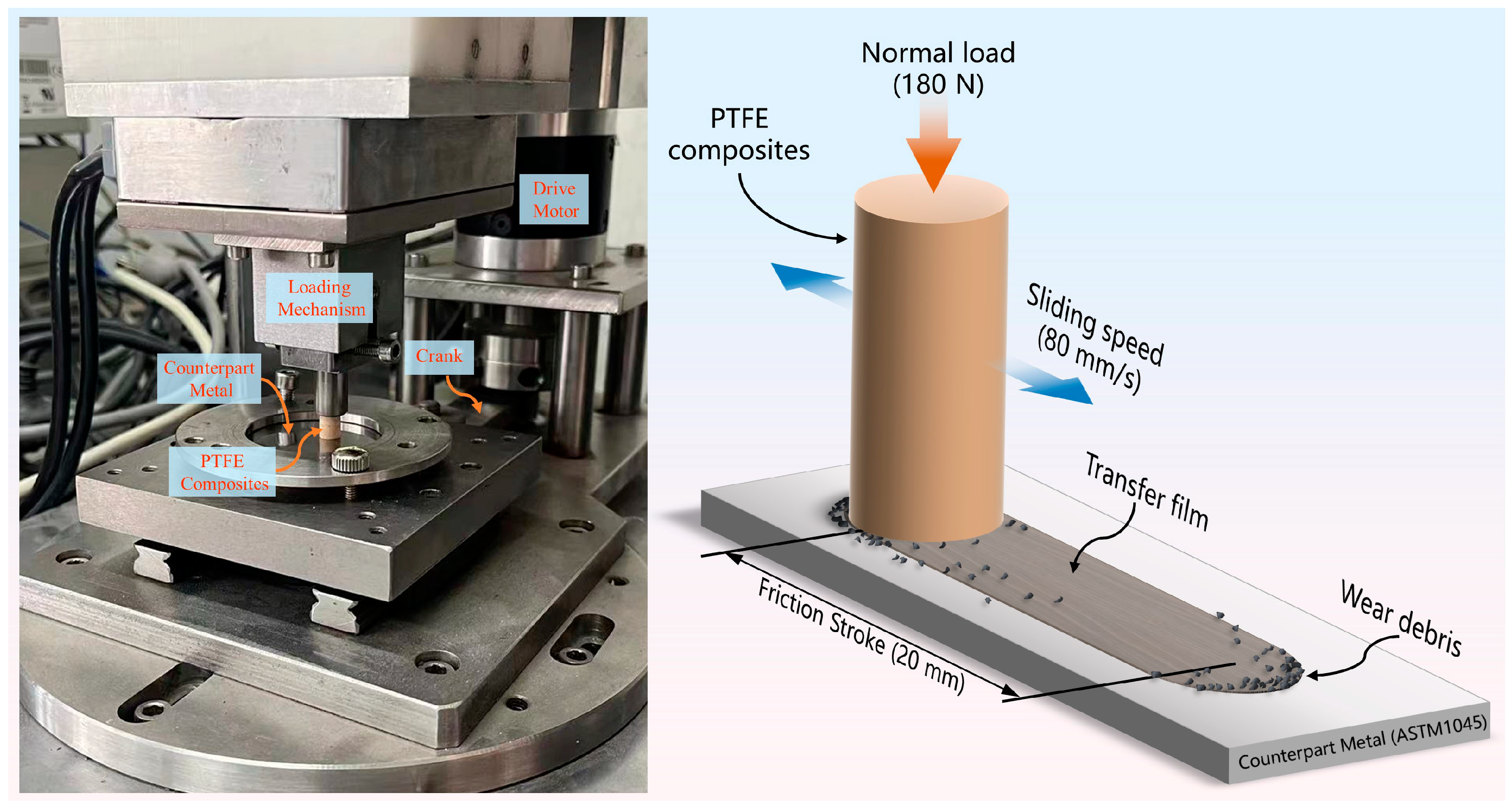
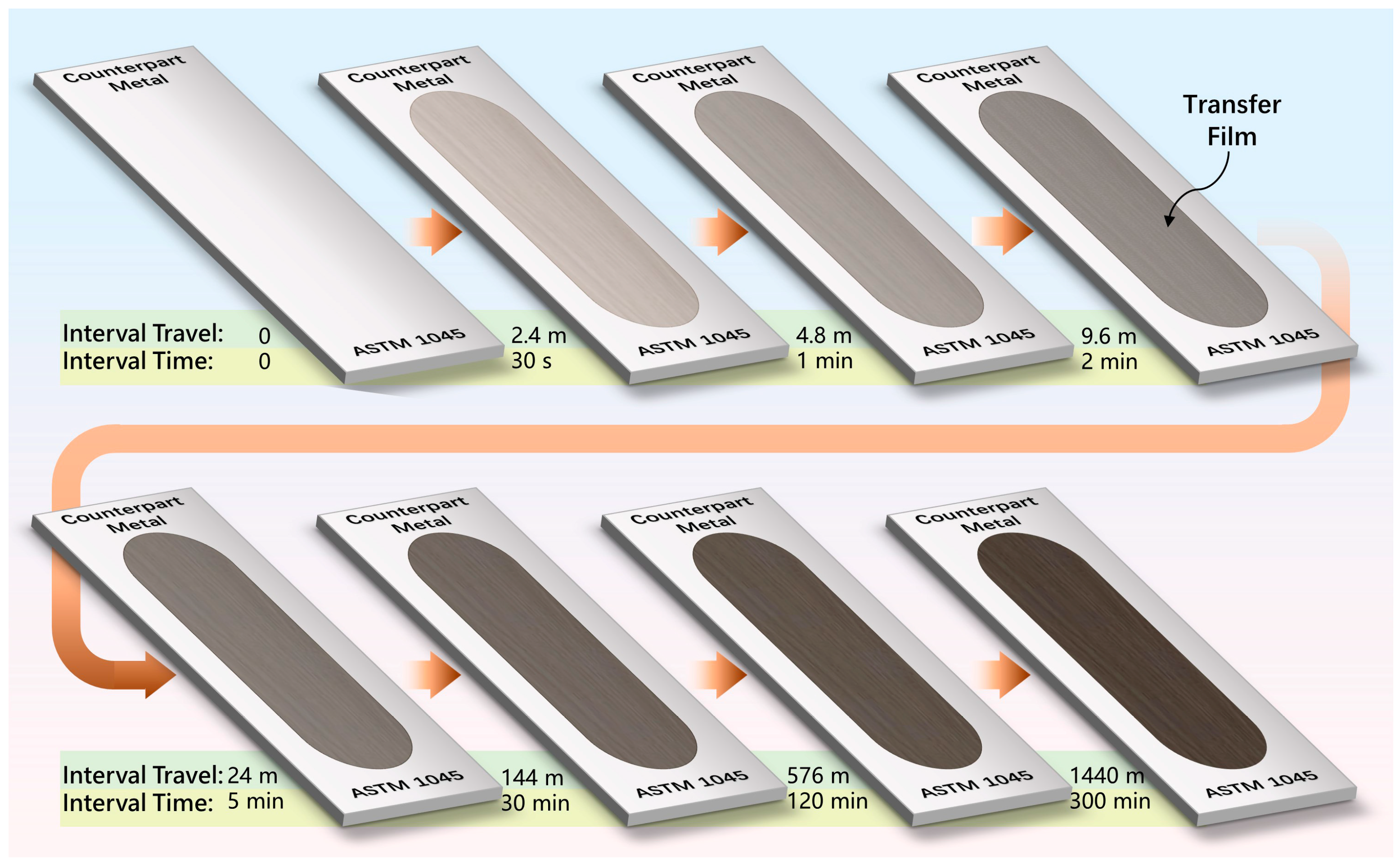
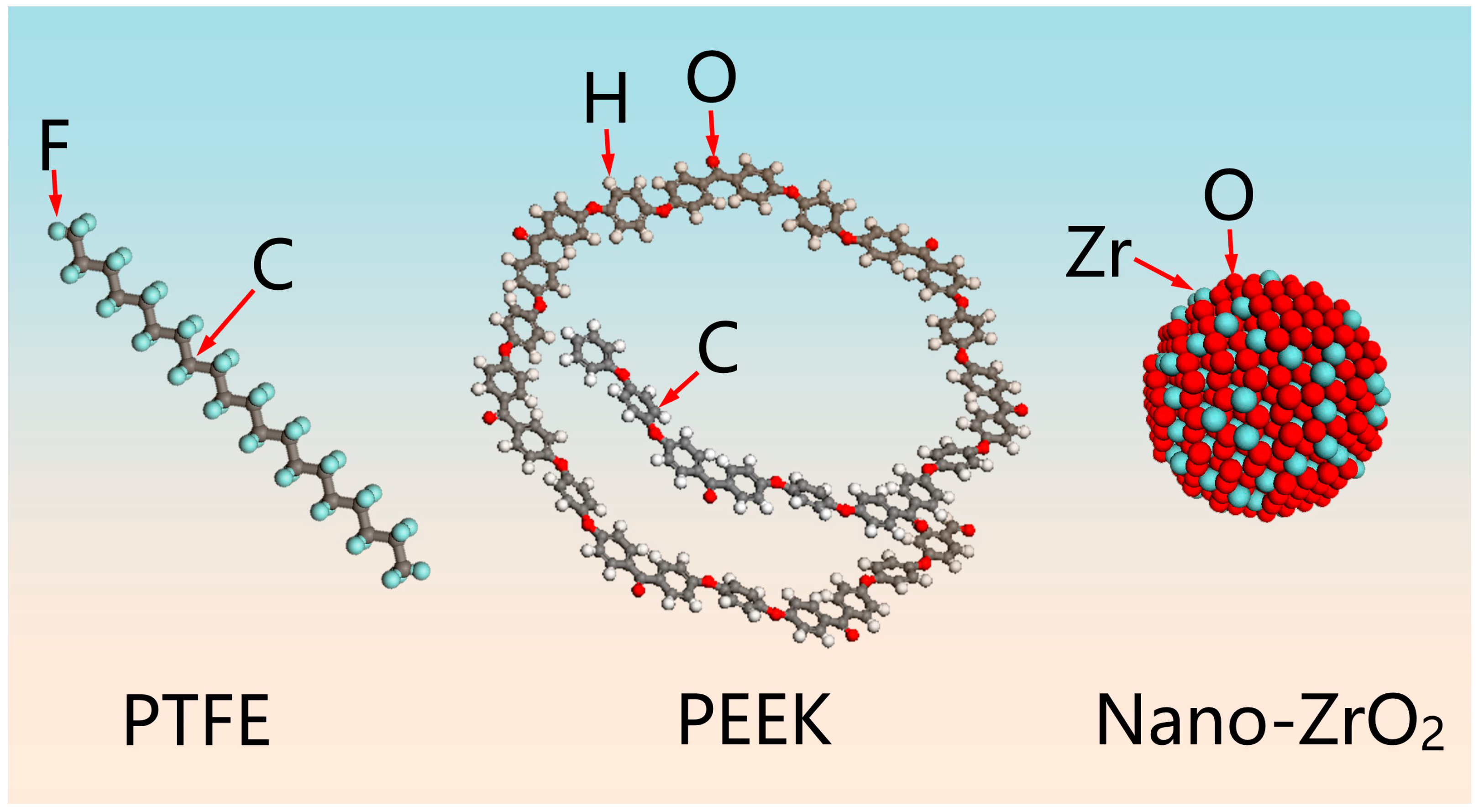


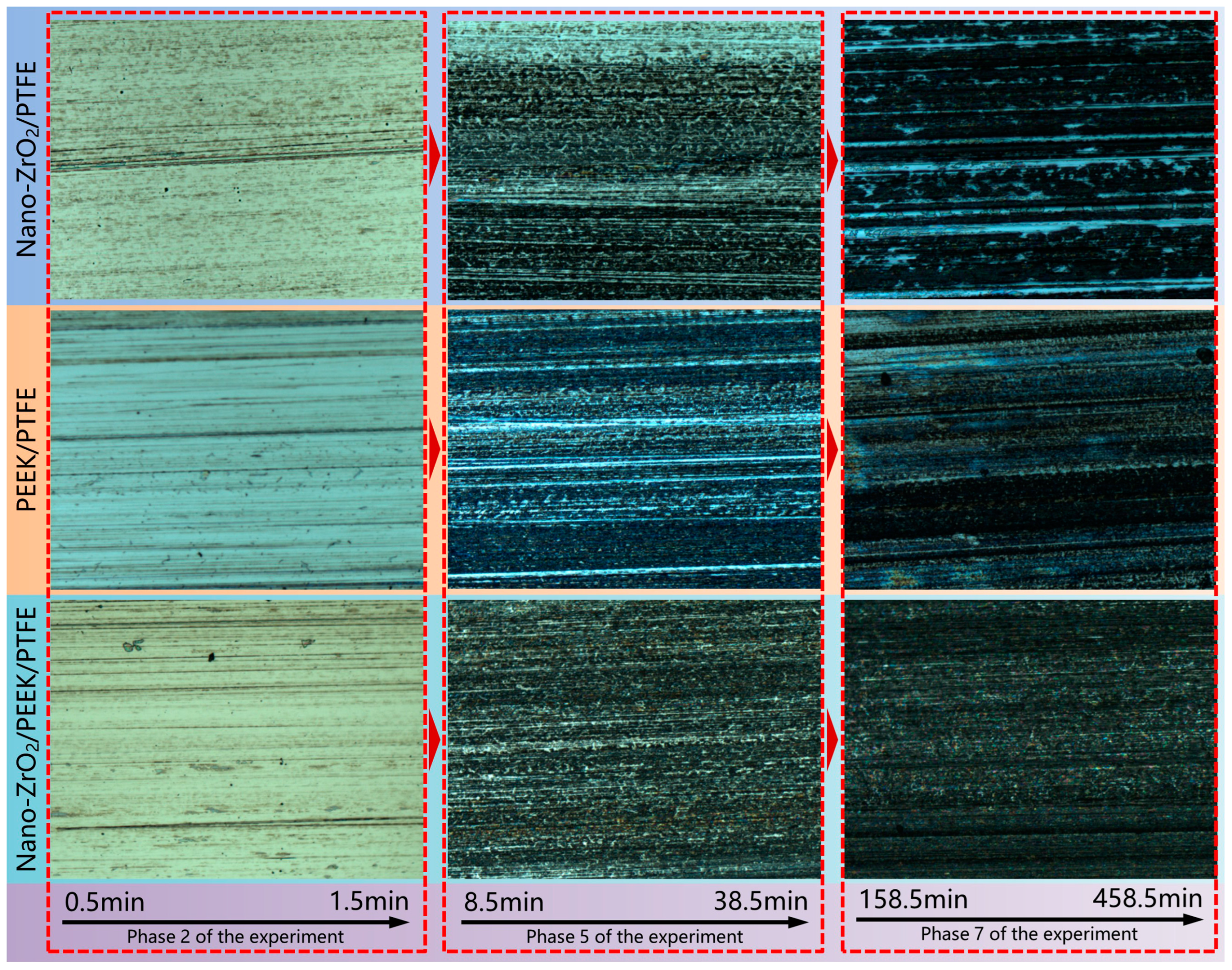
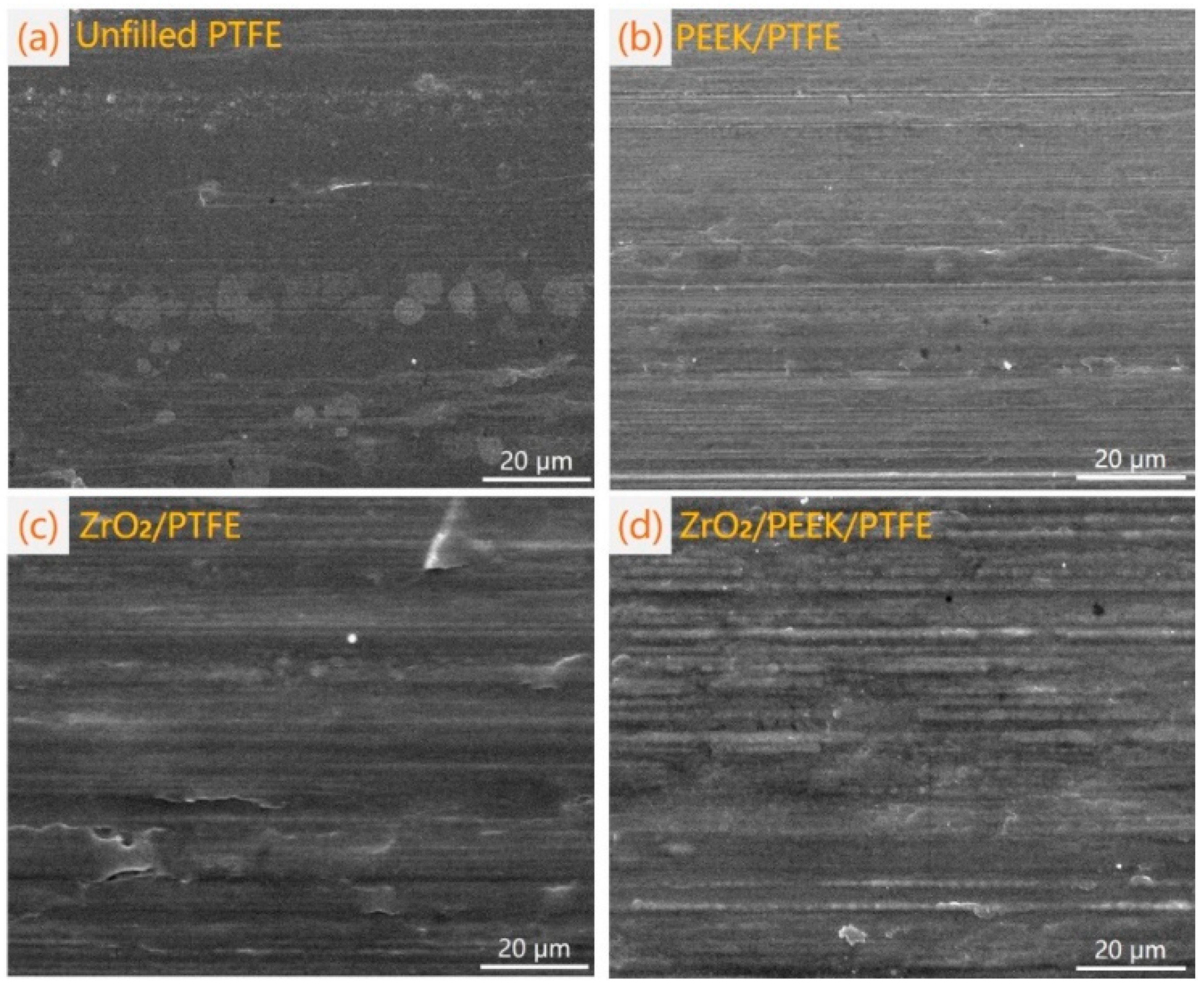




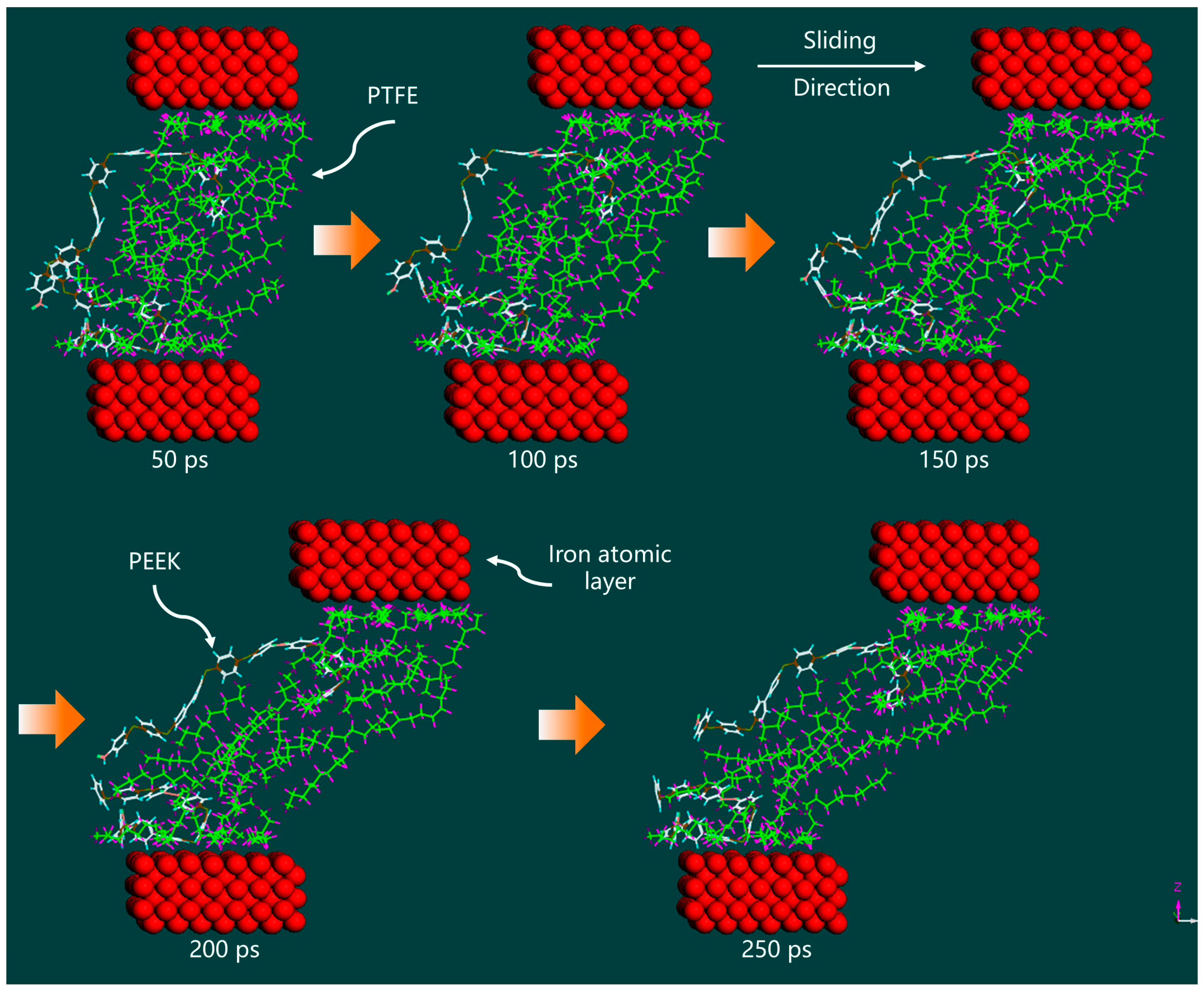


| Title | PTFE (vol.%) | PEEK (vol.%) | Nano-ZrO2 (vol.%) |
|---|---|---|---|
| Pure PTFE | 100 | 0 | 0 |
| PEEK/PTFE | 90 | 10 | 0 |
| Nano-ZrO2/PTFE | 92 | 0 | 8 |
| Nano-ZrO2/PEEK/PTFE | 82 | 10 | 8 |
Disclaimer/Publisher’s Note: The statements, opinions and data contained in all publications are solely those of the individual author(s) and contributor(s) and not of MDPI and/or the editor(s). MDPI and/or the editor(s) disclaim responsibility for any injury to people or property resulting from any ideas, methods, instructions or products referred to in the content. |
© 2023 by the authors. Licensee MDPI, Basel, Switzerland. This article is an open access article distributed under the terms and conditions of the Creative Commons Attribution (CC BY) license (https://creativecommons.org/licenses/by/4.0/).
Share and Cite
Qi, Y.; Sun, B.; Zhang, Y.; Gao, G.; Zhang, P.; Zheng, X. Tribological Properties of Nano-ZrO2 and PEEK Reinforced PTFE Composites Based on Molecular Dynamics. Lubricants 2023, 11, 194. https://doi.org/10.3390/lubricants11050194
Qi Y, Sun B, Zhang Y, Gao G, Zhang P, Zheng X. Tribological Properties of Nano-ZrO2 and PEEK Reinforced PTFE Composites Based on Molecular Dynamics. Lubricants. 2023; 11(5):194. https://doi.org/10.3390/lubricants11050194
Chicago/Turabian StyleQi, Yuan, Bugong Sun, Yang Zhang, Gui Gao, Peng Zhang, and Xiaobao Zheng. 2023. "Tribological Properties of Nano-ZrO2 and PEEK Reinforced PTFE Composites Based on Molecular Dynamics" Lubricants 11, no. 5: 194. https://doi.org/10.3390/lubricants11050194





